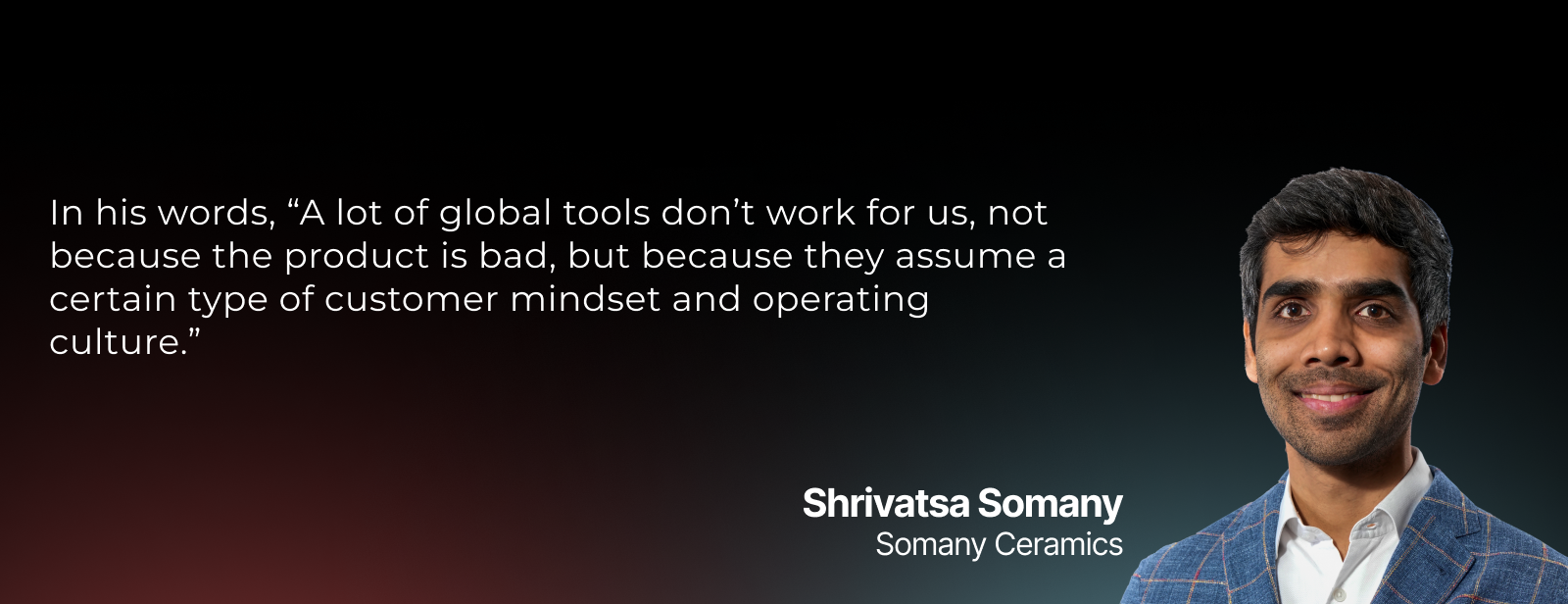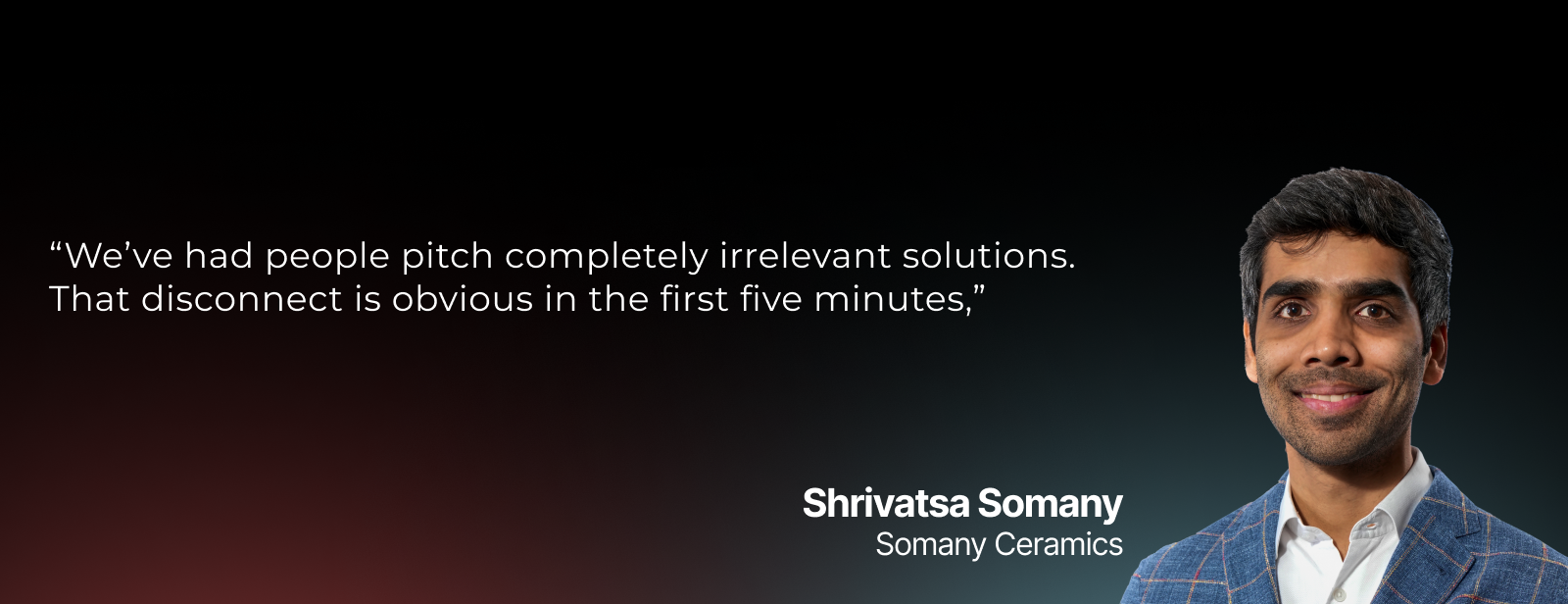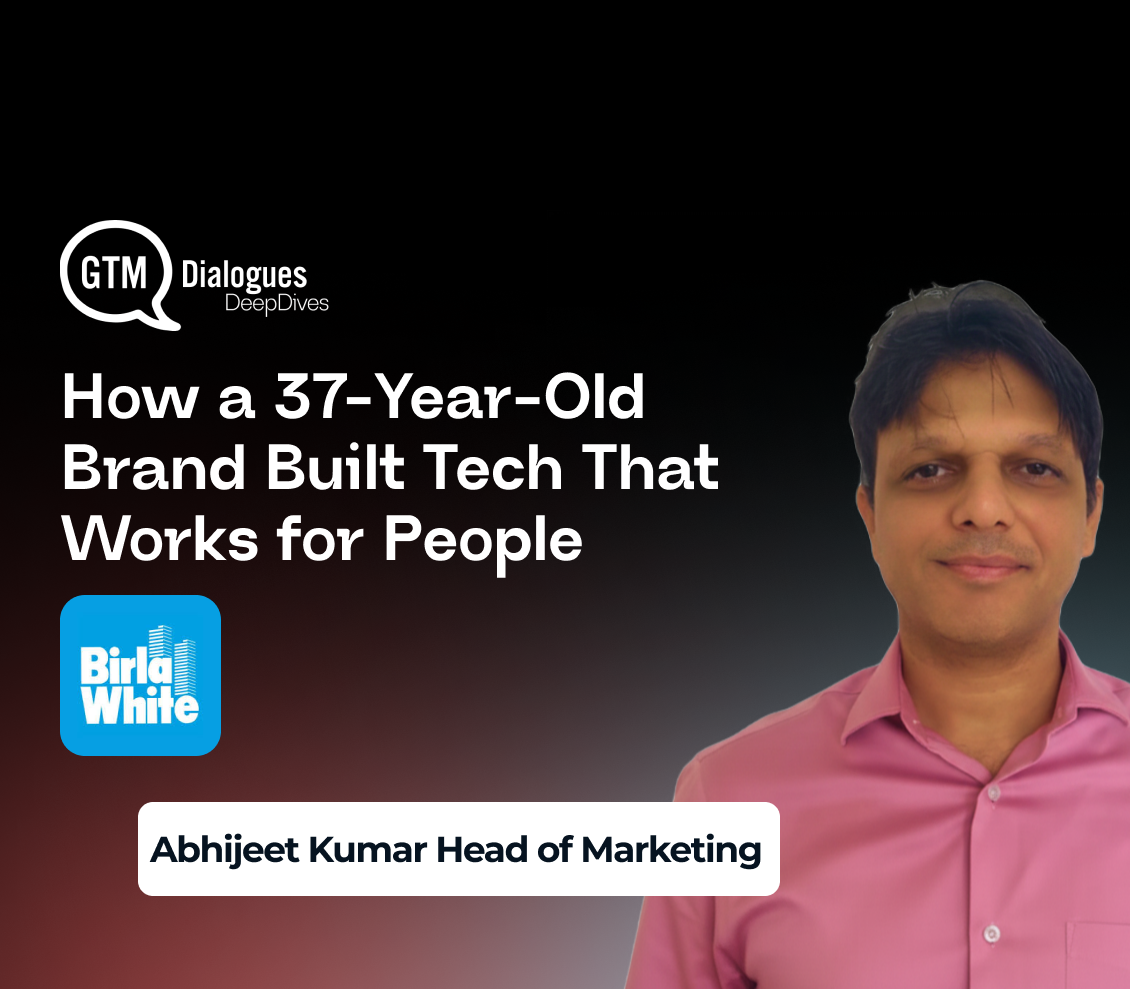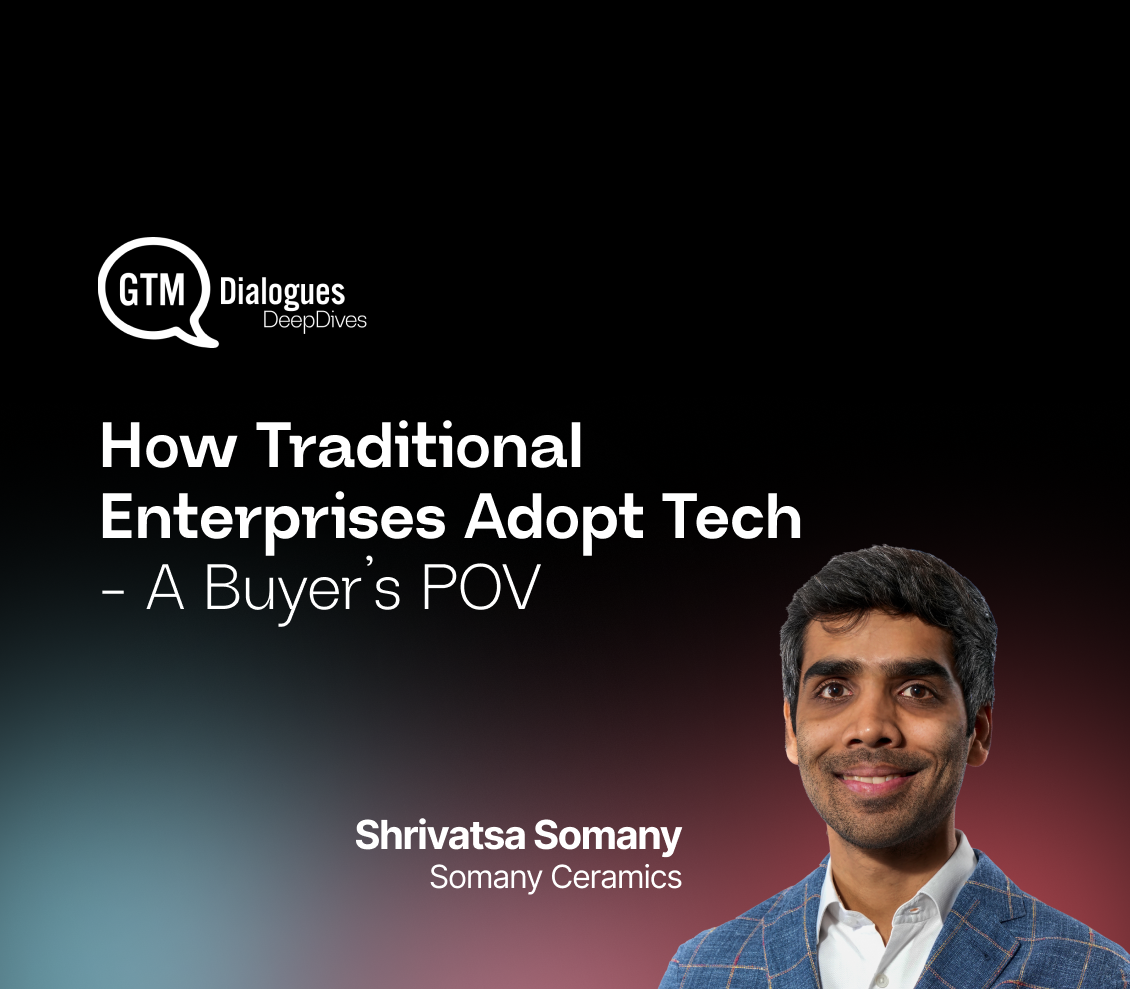Sometimes your product doesn’t land with traditional enterprises even when the need feels obvious. Right? And, it’s rarely about the technology. Mostly, it’s about whether it fits into their everyday reality.
At our recent GTMDialogues Deep Dives session, Shrivatsa Somany, Head of Bathware at Somany Ceramics, shared a detailed look at how legacy enterprises are actually adopting technology today and what they expect from startups trying to sell to them.
From rethinking loyalty programs and CRM integration to automating dealer relationships and warehouse operations, this conversation offered a rare inside view into a legacy brand actively reworking its systems for scale.
You’ll learn:
- How tech adoption works when margins are tight and processes are deeply manual
- What early-stage founders often get wrong about selling into mid-size and large Indian enterprises
- Why integration, onboarding, and internal buy-in matter more than feature sets
- How Somany is prioritizing tech investments across customer service, inventory, and sales enablement
- And how to approach buyers in traditional industries with relevance and context, not just a good demo
This session captured what enterprise buyers expect today and what you need to get right if you're selling to them.
How Legacy Enterprises Actually Buy Technology
Selling to traditional industries requires more than a good product. You need to know how buying decisions are made, what slows them down, and what actually gets implemented.
Yet, much of the available content focuses either on high-level trends or on startups that already operate in digitally native environments. What often gets overlooked is the actual buying behaviour inside long-established, operationally complex enterprises.
GTMDialogues hosted a Deep Dives session on 18th July 2025 with Shrivatsa Somany, Head of Bathware at Somany Ceramics, a 53-year-old manufacturer in the building materials space.
The focus was clear: how traditional enterprises buy, adopt, and implement technology, and what founders often miss when trying to sell into these organisations.
Shrivatsa spoke from direct experience, managing both operational and digital initiatives inside a company that runs on distributed dealer networks, high-volume SKUs, and legacy systems.
Here’s what the conversation covered:
- What triggers tech adoption in manufacturing-led organisations
- How dealer expectations are influencing system upgrades
- Why certain tools fail at the implementation stage
- What kind of solutions actually get prioritised internally
- How vendors are evaluated not just by features, but by support and fit
If you're building for Indian enterprises, especially in sectors like construction, manufacturing, or distribution, this session broke down what it really takes to sell into these markets, beyond demos and feature decks.
The Reality of Tech Adoption in Legacy Businesses
If you’ve assumed that all enterprises move at the same pace when it comes to technology, you may need to recalibrate. One of the most important insights from the session with Shrivatsa Somany was this: the rate and nature of tech adoption varies significantly even within traditional sectors.
Here are some grounded observations that stood out:
1. Not all building material categories are at the same stage
Take paints and tiles as an example. While some companies in the paints industry are known for using data to track product movement down to the wall it’s applied on, the tiles and bathware segment is still in a much earlier phase of digitization.

This unevenness isn’t due to lack of intent, it’s structural. In segments like bathware and tiles, where product replacement cycles are long, customer interaction is infrequent, and dealer sizes are small, the case for tech has to be built more carefully.
2. Change in buyer behavior is influencing demand for tech
Many of the dealers working with Somany Ceramics now belong to the second generation. Unlike their predecessors, they are more familiar with digital tools and expect seamless, app-based systems to manage orders, check inventory, and redeem loyalty rewards.
This shift is creating internal pressure on companies like Somany to modernize, not just for efficiency, but to retain relevance with their own distribution network.
3. Software built for India needs to reflect Indian realities
Shrivatsa highlighted that traditional Indian businesses are wired differently. While they are open to adopting software, they expect:
- A clear, short-term value proposition
- Minimal disruption to existing processes
- Support for scale across languages, geographies, and roles
- Pricing models that align with Indian cost structures

If you’re building or selling software in this space, these expectations are not limitations—they’re design requirements.
How Somany Ceramics Is Using Tech to Solve Ground-Level Problems
Rather than pursuing large-scale transformation projects, Somany Ceramics has focused on solving specific operational challenges through targeted implementations.
These decisions are driven by on-ground needs, dealer expectations, and the company’s focus on building for long-term usability.
Shrivatsa Somany outlined several areas where digital systems have been introduced as necessary responses to recurring problems.
1. Inventory control through warehouse management
One of the earlier and more impactful implementations was a warehouse management system (WMS). With millions of square metres of tile inventory moving across locations, manual tracking had become inefficient and error-prone.
By standardizing QR-code based inventory identification and centralizing inventory data, the WMS allowed the team to:
- Improve inventory accuracy
- Track goods across vendors and product lines
- Reduce overstocking and under-shipping
- Align warehousing with dealer-level demand
This system was initially implemented within the bathware division, which provided a more controlled test environment.
2. Digitizing loyalty for dealers, plumbers, and contractors
Somany’s loyalty program, Rishte, was developed to address a specific business need: increasing dealer and influencer retention in a highly competitive product segment.
Instead of relying on offline systems or paper-based programs, the company built a digital interface that:
- Allowed sub-dealers, plumbers, and architects to register and earn points
- Enabled direct engagement through mobile apps
- Simplified redemption and catalog-based reward selection
- Created a framework to push new products and updates regularly
This program is now being expanded from bathware into tiles and adhesives, with features designed to work across user types.
3. Modernizing the CRM with better usability and integration
While Somany had already licensed Microsoft Dynamics as their CRM, it remained underutilized for a long time. The internal team rebuilt the front end and integrations to make it functional for their field sales staff.
Key outcomes included:
- Real-time stock visibility for sales teams
- Easier order entry based on available inventory
- Integration with SAP to track movement and pricing
- Monitoring of travel expenses and dealer visits to improve compliance
This transition from passive to active CRM usage was a result of identifying gaps in day-to-day usability rather than platform limitations.
4. Customer service automation using AI-driven tools
For product categories like bathware that require after-sales service, Somany introduced chatbot-driven support to reduce manual interventions.
Since every physical visit (e.g., from a plumber) can cost ₹500 or more, this solution focused on helping resolve common issues in a single visit or avoiding unnecessary visits altogether.
The focus was not just on cutting costs but on improving customer response time and operational predictability.
5. Improving buyer experience with visual tools
To assist customers in making tile choices, a tile visualizer tool was developed. This feature allows buyers to see how specific tile designs would appear in their own spaces, improving purchase confidence and reducing showroom back-and-forth.
It’s a small addition from a technical perspective, but one that fits tightly into the buying journey and has contributed to faster decision-making.
What Founders Get Wrong About Selling to Enterprises
Throughout the discussion, Shrivatsa Somany pointed out several recurring issues he sees in early-stage product conversations, especially with startups pitching into legacy industries.
These aren’t abstract objections. They’re often the reason why otherwise good products don’t move beyond the demo.
1. Underestimating the time and effort needed for implementation
Most enterprise buyers are not only evaluating the tool, they’re also evaluating the cost of switching. According to Shrivatsa, founders often underestimate:
- How long integrations will take
- The internal training and coordination required
- How resistant existing teams might be to a new process
This becomes a problem when a vendor promises a four-week implementation and it stretches to four months. Enterprise teams lose trust quickly if delivery doesn’t match initial expectations.
Advice: If you're quoting a timeline, build in a buffer for adoption, not just deployment.
2. Focusing too much on features and not enough on business context
Many pitches center around product capabilities without first understanding how the enterprise actually works. In Somany’s case, vendors sometimes pitch features that don’t apply to their workflows, or assume usage patterns based on Western enterprise norms.
For example, systems built assuming high-margin, low-scale environments often fail in Somany's operations, where the opposite is true, tight margins and extremely high distribution volumes.
Advice: Show that you’ve understood the sector. Use examples that reflect actual operational problems, not abstract benefits.
3. Ignoring post-sale effort and long-term usability
Even when a pilot goes well, many solutions fall short during full-scale rollout. Shrivatsa highlighted that the biggest success factor is not the product, it’s how well it’s implemented and maintained.
- Is there clear documentation?
- Can their team get support without delays?
- Does the product continue to deliver value after the initial setup?
Founders focused only on “getting the sale” often underestimate how much day-to-day effort goes into making sure the product is used correctly.
Advice: Make onboarding your strongest feature. Enterprises don’t just want a product, they need a solution that works in their context, with minimal friction.
To summarize, Shrivatsa didn’t suggest that enterprises resist change. What he described instead was a process that’s influenced by internal bandwidth, cross-functional coordination, and cautious decision-making factors that aren’t always visible to a vendor during a demo.
Is Somany Open to Working with Startups?
Yes, but the product must be relevant and ready
Shrivatsa Somany clarified that Somany Ceramics is open to working with early-stage startups. However, the product must directly align with a current business need. It’s not about how big or well-funded the company is what matters is:
- The problem being solved is specific and real
- The solution fits into their current operations
- There’s clarity on how it will be implemented
A generic product pitch with vague benefits usually doesn’t move forward.
Founders are expected to understand the industry
One of the key points Shrivatsa made was that preparedness makes a strong first impression. Founders don’t need to be industry experts, but they must demonstrate basic understanding of:
- The role of dealers in the value chain
- How products move through distribution
- The operational realities of manufacturing and field sales

On the other hand, teams that come in with a clear use case, something that maps to an actual workflow are taken seriously, regardless of their size or age.
The decision-making cycle is longer than most expect
Even when there is initial interest, large enterprises need time to:
- Scope the solution
- Allocate internal resources
- Align departments involved in the rollout
This means startups must plan for longer sales cycles and stay in touch beyond the initial meeting.
A central access point is being created for startup engagement
To make the process smoother, Somany Ceramics is setting up a structured channel where startup teams can submit product details. This reduces:
- Delays in finding the right stakeholder
- Risk of conversations getting lost in follow-ups
It’s a practical step that reflects their willingness to engage with newer companies as long as the offering is thoughtfully positioned.
If you're building for traditional industries, you don’t need a large sales team or an elaborate demo. You need relevance, clarity, and a good understanding of the buyer’s world. The opportunity is there, but it requires a structured and well-prepared approach.
What’s Next for Somany in 2025?
Rather than pursuing large-scale digital transformation, Somany Ceramics is focusing on solving immediate operational challenges through systems that are scalable, practical, and easy to integrate.
Improving dealer interactions
- Streamlining order placement, scheme tracking, and info access
- Reducing manual follow-ups and support dependency
- Improving order accuracy and visibility into demand
Making lead tracking more reliable
- Moving beyond lead capture to track actual conversions
- Addressing attribution gaps, especially in cash-based sales
- Building systems to connect leads with real purchase data
These improvements reflect a larger principle in Somany’s approach: solve what’s blocking daily operations today, and scale what proves useful.
Several other initiatives are also in motion, including:
- Streamlining internal documentation and compliance-related workflows.
- Improving how legal and financial records are stored and retrieved.
- Building more visibility into product performance across different geographies.
While these may seem like backend improvements, Shrivatsa emphasized that they play a direct role in enabling more responsive decision-making and reducing operational friction across the board.
Overall, the approach is measured but intentionally-focused on making steady progress in areas where digital tools can offer clear returns, without adding complexity for the sake of it.
What should you keep in mind when building for traditional enterprises?
If you’re working in B2B tech, especially in sectors like manufacturing, infrastructure, or distribution, it’s easy to assume that traditional businesses are slow to adopt new tools. But in reality, they aren’t disinterested in technology. They just evaluate it differently.
During the session with Shrivatsa Somany, one message came through clearly: decisions aren’t made because something is “modern” or “innovative.” They’re made when the solution fits the business.
And more often than not, that means aligning with processes that already work and improving them without disrupting everything else.
For companies like Somany Ceramics, every new tool comes with a set of practical questions:
- Will this make day-to-day work easier or more complicated?
- Can the team adopt it without a long learning curve?
- Is the value obvious within a few months, not just on paper?
It’s not about hesitation. It’s about making sure any change leads to progress, not confusion.
How should you approach these businesses as a startup?
If you're building a solution for this segment, your approach matters as much as your product. A few things can make a real difference:
- Take the time to understand how the company is structured
- Explain your product in simple, direct language
- Focus on how it will work in the real world, not just in a demo
- Offer to stay involved beyond onboarding, because adoption doesn’t happen in a week
- Don’t try to force urgency; focus instead on solving a current, visible problem
This kind of preparation builds trust. And in legacy businesses, trust often matters more than speed.
Frequently Asked Questions
1. Are traditional enterprises like Somany Ceramics open to working with startups?
Yes. As long as the product solves a real, clearly defined problem and the team comes prepared with context, startups are welcome to engage. The size or funding stage of your company matters less than your understanding of the business and your ability to support implementation.
2. What types of solutions are relevant to companies in manufacturing and building materials?
Solutions that help with dealer management, inventory visibility, field sales tracking, service automation, loyalty programs, CRM usability, or procurement efficiency are highly relevant. Tools that address workforce challenges or reduce dependency on manual processes are also well-aligned.
3. How should I approach a large enterprise as a first-time founder?
Start by learning how the company operates, especially its distribution model, workflows, and internal challenges. Use that understanding to tailor your pitch. Avoid general feature walkthroughs and instead focus on how your product fits into their existing systems and delivers short-term value.
4. What makes or breaks a potential deal?
In most cases, it’s not the product that holds things back, it’s the mismatch in expectations. Common blockers include:
- Underestimating implementation timelines
- Lack of integration with existing tools like SAP or Microsoft Dynamics
- Poor onboarding support
- Unclear ROI in the first few months
Clarity, follow-through, and simplicity go a long way.
5. How long do enterprise sales cycles typically take in this space?
The process usually takes longer than expected. Even with interest from decision-makers, internal alignment, scoping, and testing can take several months. It’s important to stay engaged and be prepared for a phased rollout.
6. Will Somany Ceramics provide a direct channel for startups to engage?
Yes. As mentioned by Shrivatsa, the company is in the process of setting up a dedicated access point where startups can share product information. This is meant to streamline discovery and make it easier to identify relevant opportunities without relying on informal introductions.





